Product Images Clonidine
View Photos of Packaging, Labels & Appearance
Product Label Images
The following 13 images provide visual information about the product associated with Clonidine NDC 50742-247 by Ingenus Pharmaceuticals, Llc, such as packaging, labeling, and the appearance of the drug itself. This resource could be helpful for medical professionals, pharmacists, and patients seeking to verify medication information and ensure they have the correct product.
image-03 - image 02

The text seems to be a table showing common adverse reactions to Clonidine hydrochloride in a fixed-dose monotherapy trial during the taper period. The table shows the percentage of patients reporting each adverse reaction for the Preferred Term, extended-release tablets, and extended-release tablets at a 0.2mg dose during week 5 and 0.4g dose during weeks 6-8. The adverse reactions include Upper Respiratory Tract Infection, Headache, Constipation, Somnolence, Fatigue, and Dry Mouth.*
image-04 - image 03
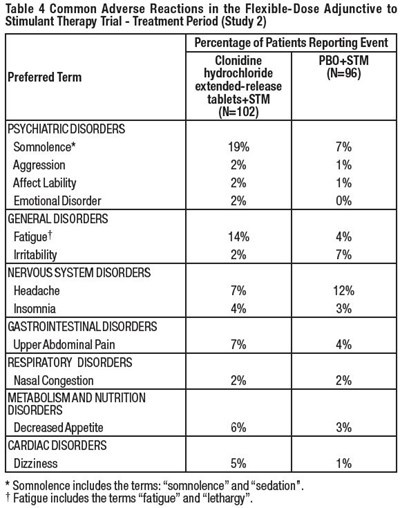
This is a table of common adverse reactions observed during the treatment period in Study 2 of the Flexible-Dose Adjunctive to Stimulant Therapy Trial. Two medications Clonidine hydrochloride and extended-release tablets+STM were used, and the percentage of patients reporting an event is shown for each medication. The adverse reactions are categorized into Psychiatric disorders, General disorders, Nervous system disorders, Gastrointestinal disorders, Respiratory disorders, Metabolism, and nutrition disorders, and Cardiac disorders. Some of the reported adverse reactions include somnolence, aggression, irritability, headache, and decreased appetite.*
image-05 - image 04
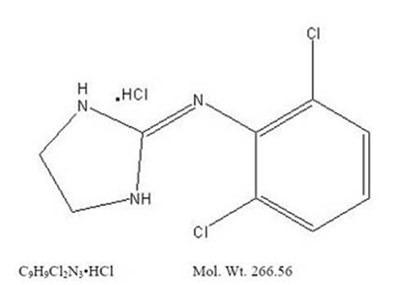
The provided text is not available as it consists of only a chemical formula and molecular weight. There is no context or information provided to generate a useful description.*
image-06 - image 05

Table 7 shows the pharmacokinetic parameters of Clonidine in healthy adult volunteers. The table displays information on the mean and standard deviation of Clonidine's various forms (immediate-release tablets - fasted, immediate-release tablets - fed, and extended-release tablets) and its parameters such as Cmax, AUClas, Tmax, and T1/2.*
image-07 - image 06
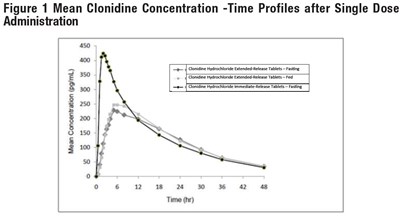
This is a graph showing the mean concentration-time profiles of Clonidine after single-dose administration for different versions of tablets and under different conditions (fasting and fed). The x-axis represents time in hours, and the y-axis represents the mean concentration of the drug in picograms per milliliter (pg/mL). There are three different lines in the graph, representing Clonidine Hydrochloride Extended-Release Tablets when taken while fasting or fed, and Clonidine Hydrochloride Immediate-Release Tablets when taken while fasting.*
image-08 - image 07
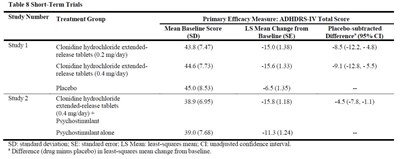
The text provides a table with results of short-term trials for two studies. The primary efficacy measure used is ADHDRS-IV Total Score. The table includes the treatment group, mean baseline score, LS mean change from baseline, and placebo-subtracted SE difference. Clonidine hydrochloride extended-release tablets (0.2 mg/day) and (0.4 mg/day) were studied in the first study, along with a placebo. Clonidine hydrochloride extended-release tablets (0.4 mg/day) with psychostimulant and psychostimulant alone were studied in the second study. The study results are presented in a tabular format.*
image-09 - image 08
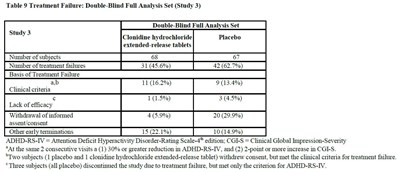
The text is a table showing the treatment failure rate of a study 3 for Clonidine hydrochloride extended-release tablets compared to placebo. The study was conducted on a group of 68 subjects. The treatment failure rate was 45.6%. The basis of treatment failure is listed, which includes lack of efficacy, withdrawal of consent, and other early terminations. The ADHD-RS-IV and CGI-S scales were used to assess treatment efficacy. The text also mentions that two subjects withdrew consent but still met the clinical criteria for the treatment, and three subjects discontinued the study due to treatment failure, but met only the ADHD-RS-IV criterion.*
image-10 - image 09
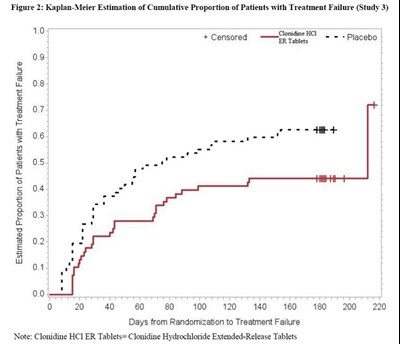
The text is a figure caption that shows a graph called Kaplan-Meier Estimation of Cumulative Proportion of Patients with Treatment Failure in Study 3. The graph displays the estimated proportion of patients with treatment failure over time (measured in days from randomization to treatment failure) using Clonidine Hydrochloride Extended-Release Tablets and a placebo. The graph shows the proportion of patients for each of the listed days, which are represented on the x-axis. The y-axis represents the estimated proportion of patients with treatment failure.*
image-13 - image 12

This appears to be a description of a medication called Clonidine Hydrochloride. The medication comes in tablet form and is available in a 0.1 mg dosage. There is an extended release option, which can be used as a substitute for the regular clonidine hydrochloride tablets. There are additional numbers and codes listed, but their meaning is not clear from the text.*
image-14 - image 13
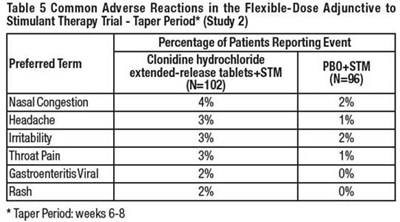
This is a table presenting the common adverse reactions reported by patients during the Taper Period of the Flexible-Dose Adjunctive to Stimulant Therapy Trial (Study 2). The adverse reactions reported include nasal congestion, headache, nasal or throat irritation, viral gastroenteritis and rash. The percentage of patients who reported each adverse event is also provided.*
* The product label images have been analyzed using a combination of traditional computing and machine learning techniques. It should be noted that the descriptions provided may not be entirely accurate as they are experimental in nature. Use the information in this page at your own discretion and risk.


